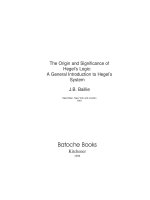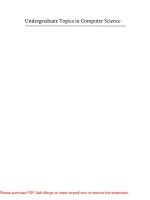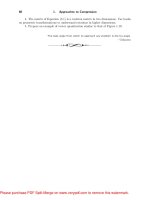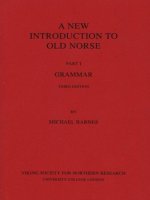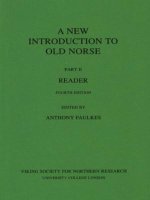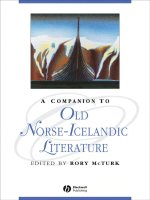a new introduction to old norse part i grammar
Bạn đang xem bản rút gọn của tài liệu. Xem và tải ngay bản đầy đủ của tài liệu tại đây (839.8 KB, 283 trang )
A NEW INTRODUCTION TO OLD NORSE
PART I: GRAMMAR
A NEW
INTRODUCTION TO
OLD NORSE
PART I
GRAMMAR
THIRD EDITION
BY
MICHAEL BARNES
VIKING SOCIETY FOR NORTHERN RESEARCH
UNIVERSITY COLLEGE LONDON
2008
© M. P. Barnes 1999/2004/2008
ISBN: 978-0-903521-74-1
First published 1999
Reprinted with corrections and additions 2001
Second edition 2004
Third edition 2008
Printed by Short Run Press Limited, Exeter
Preface
This Grammar is intended for university students with no previous
knowledge of Old Norse. It covers considerably more than the essen-
tials, however, and is suitable for study up to first degree level. Full
account is taken of the fact that grammatical concepts may be unfa-
miliar to many using the work, and all but the most basic are explained.
Comparison is made with English where helpful, and a glossary of
grammatical terms included at the end. Although it is possible to study
the Grammar on one’s own, the guidance of a tutor is strongly recom-
mended.
The bulk of the Grammar was available in draft by the time of the
1998–99 session, and was tried out by several teachers at British uni-
versities. Content and presentation have benefited greatly from the
comments and suggestions of both teachers and students. I would like
in particular to thank Alison Finlay, Judith Jesch and Svanhildur
Óskarsdóttir, who offered many valuable insights, Peter Foote, who
read the whole work and improved it in countless ways, and finally
Anthony Faulkes, who not only commented on numerous points of
detail but designed the layout and saw the production of the book
through from start to finish. Needless to say, such faults as remain are
my responsibility.
Michael P. Barnes
University College London
July 1999
Preface to second edition
The necessity for a further reprint has made it possible to introduce a
number of corrections and changes, and to add a new section on points
of syntax (3.9.9).
Users will also be pleased to know that there is now a CD that can
be obtained from the Viking Society containing extracts I, II, IV, VIIB,
VIII (b) and (e), IX and X from NION II read with Modern Icelandic
pronunciation by Icelanders: Selected Readings from A New Intro-
duction to Old Norse, published by The Chaucer Studio, 2003.
April 2004
Preface to third edition
The book has been corrected and revised throughout, and a postscript
added (pp. 262–3).
May 2007
Contents
Abbreviations and Symbols xii
1. Introduction
1.1 The aim of the Grammar 1
1.2 What is Old Norse? 1
1.3 Old Norse and modern English 2
1.4 Pronunciation 3
1.5 Orthography 4
1.6 General advice to the student 5
2. Pronunciation and Orthography
2.1 Old Norse 8
2.1.1 Pure vowels 8
2.1.1 Exercise 9
2.1.2 Diphthongs 9
2.1.2 Exercise 10
2.1.3 Consonants 10
2.1.3 Exercise 12
2.1.4 Syllables 13
2.1.4 Exercise 13
2.2 Modern Icelandic 14
2.2.1 Vowels 14
2.2.1 Exercise 16
2.2.2 Consonants 16
2.2.2 Exercise 20
2.2.3 Syllables 20
2.2.4 The epenthetic vowel 20
2.2.3/2.2.4 Exercise 21
3. Morphology and Syntax
3.1 Noun inflexions and their function 22
3.1.1 Number 22
3.1.2 Case 22
3.1.3 Gender 27
3.1.1/3.1.2/3.1.3 Exercise 28
3.1.4 Basic noun inflexions 28
3.1.4 Exercise 31
3.1.5 Examples of noun usage 31
3.1.5 Exercise 37
3.1.6 Difficulties in recognising noun inflexions
and ways of overcoming them 37
3.1.6 Exercise 39
3.1.7 Important variations in noun inflexion 39
3.1.7.1 Labial mutation 39
3.1.7.1 Exercise 41
3.1.7.2 Front mutation 41
3.1.7.2 Exercise 44
3.1.7.3 Breaking 44
3.1.7.4 Deviations from the basic endings 45
3.1.7.5 Minor irregularities 45
3.1.7.3/3.1.7.4/3.1.7.5 Exercise 46
3.1.8 Examples of noun inflexion 47
3.1.8 Exercise 53
3.1.9 The suffixed definite article 56
3.1.9 Exercise 58
3.2 Pronoun inflexions and their function 60
3.2.1 Personal pronouns: form 61
3.2.2 Demonstrative pronouns: form 63
3.2.3 Indefinite pronouns: form 65
3.2.4 Negative pronouns: form 66
3.2.5 Interrogative and distributive pronouns: form 67
3.2.1/3.2.2/3.2.3/3.2.4/3.2.5 Exercise 68
3.2.6 Examples of pronoun usage 68
3.2.6 Exercise 76
3.3 Adjective inflexions and their function 77
3.3.1 Number, case and gender 77
3.3.2 Definiteness 78
3.3.3 Degree (comparison) 79
3.3.1/3.3.2/3.3.3 Exercise 79
3.3.4 Basic adjective inflexions 80
3.3.4 Exercise 84
3.3.5 The free-standing definite article 84
3.3.5 Exercise 86
3.3.6 Examples of adjective usage 87
3.3.6 Exercise 95
3.3.7 Difficulties in recognising adjective inflexions
and ways of overcoming them 96
3.3.7 Exercise 97
3.3.8 Important variations in adjective inflexion 98
3.3.8.1 Labial mutation 98
3.3.8.1 Exercise 99
3.3.8.2 Front mutation 99
3.3.8.3 Suppletive forms 100
3.3.8.4 Deviations from the basic endings 101
3.3.8.5 Minor irregularities 102
3.3.8.2/3.3.8.3/3.3.8.4/3.3.8.5 Exercise 103
3.3.9 Examples of adjective inflexion 104
3.3.9 Exercise 111
3.4 Numerals 115
3.4.1 The numerals and their inflexions 115
3.4.1 Exercise 119
3.4.2 Examples of numeral usage 120
3.4.2 Exercise 123
3.5 Adverbs 124
3.5.1 Adverb formation 124
3.5.2 Inflexion for degree 125
3.5.3 Examples of adverb usage 127
3.5.1/3.5.2/3.5.3 Exercise 129
3.5.4 Adverbs and adverbials 130
3.6 Verb inflexions and their function 131
3.6.1 Person and number 131
3.6.2 Tense 132
3.6.3 Mood 134
3.6.4 Voice 135
3.6.1/3.6.2/3.6.3/3.6.4 Exercise 136
3.6.5 Basic verb inflexions 137
3.6.5.1 Endings 137
3.6.5.1 Exercise 139
3.6.5.2 Vowel alternations 140
3.6.5.2 Exercise 143
3.6.5.3 The -sk form 144
3.6.5.3 Exercise 146
3.6.6 Finite and non-finite forms; principal parts 146
3.6.6 Exercise 152
3.6.7 Preterite presents and other irregular verbs 152
3.6.7 Exercise 155
3.6.8 Examples of verb usage 155
3.6.8 Exercise 164
3.6.9 Important variations in verb inflexion 164
3.6.9.1 Phonological variation 165
3.6.9.2 Morphological variation 168
3.6.9.3 Idiosyncratic variation 169
3.6.9.1/3.6.9.2/3.6.9.3 Exercise 171
3.6.10 Examples of verb inflexion 171
3.6.10 Exercise 177
3.7 Prepositions 181
3.7.1 Prepositions triggering the accusative 182
3.7.2 Prepositions triggering the genitive 184
3.7.3 Prepositions triggering the dative 185
3.7.4 Prepositions triggering the accusative
and dative 189
3.7.5 Prepositions triggering the accusative and
genitive 196
3.7.6 Preposition triggering the accusative,
genitive and dative 197
3.7.7 Residual remarks 197
3.7 Exercise 199
3.8 Conjunctions 200
3.8.1 Coordinating conjunctions 202
3.8.2 Subordinating conjunctions 204
3.8.2.1 The particle er 204
3.8.2.2 The particle at 212
3.8.2.3 Interrogative pronouns and adverbs 215
3.8.2.4 Other adverbial sentence introducers 218
3.8 Exercise 221
3.9 Residual points of syntax 223
3.9.1 Sentence word-order 223
3.9.1 Exercise 228
3.9.2 Word-order in noun phrases 228
3.9.2 Exercise 230
3.9.3 Impersonal constructions 230
3.9.3 Exercise 236
3.9.4 Accusative and infinitive 236
3.9.4 Exercise 240
3.9.5 Omissions 240
3.9.5.1 Objects 241
3.9.5.2 vera 241
3.9.5.3 Verbs of motion 243
3.9.5 Exercise 243
3.9.6 Points of nominal syntax 244
3.9.6.1 Idiomatic uses of personal pronouns and
possessive adjectives 244
3.9.6.2 The genitive and dative of respect 246
3.9.6 Exercise 248
3.9.7 Points of verbal syntax 248
3.9.7.1 The perfect and past perfect 248
3.9.7.2 The passive 251
3.9.7.3 The ‘dative absolute’ 253
3.9.7.4 Present participles expressing potentiality
or obligation 254
3.9.7 Exercise 255
3.9.8 Points of syntax affecting more than one
type of phrase 256
3.9.8.1 Adjectival and adverbial complements 256
3.9.8.2 Agreement between subject, verb and
subject complement 257
3.9.8.3 -sk verb forms and ‘preposition adverbs’ 259
3.9.8 Exercise 260
3.9.9 Adverbial ok 261
A postscript on ‘impersonal constructions’ 262
References to linguistic terms explained in the Grammar 264
Select glossary of linguistic terms not explained in the Grammar 266
Bibliography 270
Abbreviations and Symbols
acc. accusative
act. active
adj. adjective
art. article
aux. auxiliary
comp. comparative
COMP complementiser
dat. dative
def. definite
f. feminine
gen. genitive
imp. imperative
indic. indicative
inf. infinitive
interrog. interrogative
m. masculine
n. neuter
NION I–III A New Introduction to Old Norse I: Grammar;
II: Reader; III: Glossary and Index of Names
nom. nominative
NP noun phrase
ON Old Norse
pass. passive
pl. plural
pos. positive
pp. past participle
pres. present
refl. reflexive
REFL. POSS. reflexive possessive
sg. singular
subj. subject; subjunctive
sup. superlative
vb. verb
* reconstructed form; ungrammatical sentence
> develops to
< develops from
~ zero ending
1 Introduction
1.1 The aim of the Grammar
From the point of view of the student, many existing grammars of Old
Norse suffer from two major defects. First, they are largely constructed
on historical principles and thus contain detail about earlier stages of
the language and linguistic development, little of which is of direct
use to someone seeking to acquire a reading knowledge of Old Norse.
Second, they assume a level of linguistic sophistication which the
school system no longer cultivates, and so leave unexplained many
things which to the modern student are opaque.
The present Grammar has been written with one aim only: to facili-
tate the learning of Old Norse for as wide a range of students as possible.
It therefore eschews historical digressions except where they throw
essential light on the workings of the language, and an attempt is made
to explain all but the most basic ideas, concepts and terms on their
first appearance or, failing that, in the Select Glossary (pp. 264–6).
The emphasis throughout is pedagogical, and the work thus represents
not so much a re-think of Old Norse grammar as a re-think of the ways in
which the basics of Old Norse may be best presented to the learner.
1.2 What is Old Norse?
The term ‘Old Norse’ has been used in various ways. For some it is a
broad concept covering the language of Denmark, Norway and Swe-
den, as well as Iceland and the other Scandinavian colonies, through-
out the Viking Age (c. 750–1050) and the early and high Middle Ages
(c. 1050–1350). At the other extreme it has been taken to mean only
the Old Norwegian of the early and high Middle Ages. In the present
context it is used principally to signify the language of Norway in the
period c. 750–1350 (after which Norwegian changes considerably) and
of Iceland from the settlement (c. 870) to the Reformation (c. 1550 —
a date that sets a cultural rather than a linguistic boundary). Known in
modern Icelandic as norræna, in Norwegian as norrønt and in English
sometimes as Old West Norse, this type of speech is a western variety
2 A New Introduction to Old Norse
of Scandinavian. Scandinavian itself represents the northern branch
of the Germanic group of languages, whose western branch includes
Dutch, English and German.
As a result of Viking-Age expansion, Old Norse (in the sense just
defined), which had its origins in Norway, came to be spoken in such
widely different places as Faroe, Greenland and Ireland, but it was
only in Iceland and Norway — especially the former — that a signifi-
cant scribal culture developed, and it is upon manuscripts in Icelandic
and Norwegian written with the roman alphabet that our knowledge
of Old Norse is chiefly based. The earliest Icelandic and Norwegian
vernacular manuscripts that have survived are dated to c. 1150, but the
bulk are from the thirteenth and fourteenth centuries, and many Ice-
landic manuscripts are later still. For insights into Old Norse prior to
1150 we are dependent on runic inscriptions, bits and pieces preserved
in foreign language sources, and verse composed in the Viking Age
but recorded in medieval manuscripts.
Although Icelandic c. 870–1550 and Norwegian c. 750–1350 are
here given the designation ‘Old Norse’, it would of course be wrong
to think of this language as entirely uniform, without variation in time
or space. The form of Scandinavian spoken in Norway around 750
differed in a number of important respects from that spoken around
1350, and by the latter date the Norwegian carried to Iceland by the
original settlers had begun to diverge from the mother tongue. Never-
theless, in the period c. 1150–1350, when the great medieval literature
of Iceland and Norway was created, there existed an essential unity of
language in the western Scandinavian world, and it is on that unity
that the present Grammar is based.
1.3 Old Norse and modern English
A major difference between Old Norse and modern English is that Old
Norse is a much more highly inflected language. Modern English still
has certain inflexions, by which is meant that words change their form
according to their function in a sentence (e.g. she came, I saw her; sg.
cat, pl. cats; pres. run, past ran), but Old Norse has a far greater number.
In English the function of a word can often be deduced from its posi-
tion in relation to other words. We understand:
Introduction 3
Olav saw the old woman
to mean that Olav was the one who saw and the old woman the one
who was seen because Olav precedes saw. Reverse the order and the
opposite applies. In a corresponding Old Norse sentence it would be
perfectly possible for the order to be reversed without a change in
meaning. Everything would depend on the inflexions. Thus:
Óláfr sá konu flá ina gƒmlu
and
Konu flá ina gƒmlu sá Óláfr
both mean ‘Óláfr saw the old woman’, because the forms Óláfr and
konu flá ina gƒmlu are unchanged. If we wish the sentence to mean
‘the old woman saw Óláfr’, we must alter the forms of the words so that
Óláfr becomes Óláf and konu flá ina gƒmlu becomes kona sú in gamla.
It is obvious, therefore, that from the very start the student will
have to pay the closest attention to inflexions. Failure to do so will
result in the regular misunderstanding of Old Norse texts.
1.4 Pronunciation
Even in the case of dead languages, pronunciation is of some impor-
tance. If students cannot translate letters on the page into sounds, it
becomes well-nigh impossible for them to discuss the language they
are trying to learn. Furthermore, for those without an exclusively visual
memory, the association of image and sound is a valuable aid to
learning.
The pronunciation of Old Norse, like that of Latin, varies from coun-
try to country and sometimes from teacher to teacher. In the English-
speaking world a widespread practice is to adopt modern Icelandic
pronunciation. Although it is often claimed there is little difference
between modern Icelandic and Old Norse (and this is true enough as
regards the inflexional system and the basic vocabulary), the pronun-
ciation has changed a great deal since the first centuries of the settle-
4 A New Introduction to Old Norse
ment of Iceland. The adoption of modern pronunciation, while putting
the learner at some distance from the speech of those who wrote the
literature s/he is reading, nevertheless has the great advantage that
one can in effect listen to native speakers reproducing the language,
and thus learn to read aloud not only with fluency but with natural
intonation (patterns of voice pitch). For those whose chief interest is
Old Norse literature, modern Icelandic pronunciation has much to
recommend it. The pure language student, on the other hand, will find
the modern pronunciation frustrating: not only does it obscure the re-
lationship between several common sounds — and thus also between
large numbers of words or word-forms — it can render meaningless
rules involving syllable length (especially important in poetry). In the
present work, therefore, an outline is given of the pronunciation both
of Old Norse and of modern Icelandic. For the former we can rely to a
considerable extent on a twelfth-century work, the so-called First
Grammatical Treatise (ed. Haugen 1972; Hreinn Benediktsson 1972),
which discusses in some detail the vowel and consonant sounds of the
Icelandic of that age. This, together with what we can deduce from
spelling, historical comparisons and modern pronunciation (Icelandic
and different varieties of Norwegian) means that guidance on the
essentials of Old Norse pronunciation during the golden years of literary
production can be offered with reasonable confidence.
1.5 Orthography
The scribes who wrote Old Norse did not conform to standardised
rules of spelling, any more than their counterparts in medieval Eng-
land and elsewhere. They wrote words more or less as they had been
trained to do at the scriptorium where they studied, although they might
also be influenced by forms in an exemplar from which they were
copying — and occasionally by their own pronunciation. The result is
that most Old Norse words appear in manuscripts in a variety of spell-
ings. In order to facilitate the making of grammars, dictionaries and
text books, therefore, and to help the learner, modern scholars have
adopted a normalised orthography for Old Norse. Some editions of
Old Norse writings, designed more for the philologist and linguist
than the literary reader, follow closely the spelling of the manuscript
Introduction 5
or manuscripts on which they are based, while in others the normalised
orthography may be adapted to bring it into greater harmony with that
of the manuscript source. This last practice means that normalisation
of Old Norse does not conform to an immutable standard. Even between
grammars, text books and dictionaries a degree of variation can be
found. The present Grammar, for example, does not always acknow-
ledge the lengthening of a, o, ƒ, u which took place in twelfth–thirteenth
century Icelandic before various consonant clusters beginning with
l (e.g. hjalpa > hjálpa, folk > fólk, hjalmr > hjálmr), although such
lengthening is generally indicated in Parts II and III (Reader and
Glossary and Index of Names) of A New Introduction to Old Norse.
The conventions adopted here are in the main those found in E. V.
Gordon, An Introduction to Old Norse (1957), which deviates little from
usage in many of the major editions and dictionaries. It should be noted,
however, that the two dictionaries most used by English-speaking
students, Richard Cleasby and Gudbrand Vigfusson, An Icelandic-
English Dictionary (1957) and Geir Zoëga, A Concise Dictionary of
Old Icelandic (1910), make a few concessions to modern Icelandic
orthography (for which see, for example, Stefán Einarsson 1945, 1–31).
1.6 General advice to the student
The present Grammar is intended primarily for university students,
and how it is used will be determined largely by individual tutors.
Nevertheless, it may be helpful to both students and staff, and to any-
one studying on their own, to offer outline guidance on the learning
process — not least because it is the author’s understanding of how
Old Norse can most effectively be learnt that has determined the struc-
ture of the Grammar. With the emphasis on learning, the following
remarks are addressed direct to the student.
Decide at the outset which pronunciation to adopt, and stick to it.
Vacillating between rival pronunciations is confusing. Having decided,
read through the relevant part of section 2. Do not attempt to learn all
the rules of pronunciation at once. Read words, then phrases, then
whole sentences aloud, referring to the rules as and when necessary. If
you adopt modern Icelandic pronunciation, try to obtain recordings of
native speech.
6 A New Introduction to Old Norse
Your learning of morphology and syntax should initially be concen-
trated on the basics of nouns, pronouns, adjectives and verbs. These
are the most highly inflected word classes in Old Norse, and the most
central to the understanding of what you are reading.
Begin with the nouns. If you are uncertain about concepts like
‘number’, ‘case’ and ‘gender’, read sub-sections 3.1.1, 3.1.2 and 3.1.3
and do the accompanying exercise. Now learn the endings given in
3.1.4, noting the patterns. If you find this material too abstract, you
can compare the endings with those of the actual nouns listed in 3.1.8.
There is much greater variety of inflexion there, though, and that may
confuse rather than help you in the early stages. The noun paradigms
of 3.1.8 are meant primarily for reference as the learning proceeds.
When you are satisfied you have mastered everything in 3.1.4, do the
exercise. Next, study in detail the examples of noun usage given in
3.1.5, paying particular attention to the accompanying notes. This is
your introduction to the basics of Old Norse syntax, and you should
be prepared to spend a fair amount of time on it. When you have as-
similated all the information in 3.1.5, do the exercise. Then read through
3.1.6 and answer the questions at the end of it. Now try the exercise in
3.1.8, using a dictionary or the Glossary in NION III and the noun
paradigms listed in this sub-section. Do not worry if you do not get all
the answers right straight away; this exercise is part of the learning
process as well as a test of knowledge. Sub-section 3.1.7 on the most
important variations in noun inflexion is not intended to be read at one
go and learnt, but is there to be consulted as and when problems arise.
You should, however, familiarise yourself with the fundamentals of
labial mutation as soon as possible.
Following the nouns, section 3.1.9 on the suffixed definite article
should be studied and the accompanying exercise completed.
Now go on to section 3.2. Learn the pronoun paradigms set out here,
noting the correspondences between them, and follow this by doing
the exercise covering 3.2.1–3.2.5. Next, study in detail the examples
of pronoun usage given in 3.2.6, paying due attention to the accompa-
nying notes. When you have assimilated all the information in 3.2.6,
do the exercise.
Section 3.3 on adjectives follows largely the pattern of 3.1 on nouns,
and the various items should be tackled in the same order and manner
(with 3.3.8 for consultation as necessary, and the paradigms in 3.3.9
Introduction 7
for reference). Note, however, that the free-standing definite article is
treated immediately after basic adjective inflexions; it should be stud-
ied before you go on to the examples of adjective usage, where this
form of the article occurs quite widely.
From adjectives proceed to section 3.6 on verbs. Work through sub-
sections 3.6.1 to 3.6.8 in the order they appear (3.6.1 to 3.6.4 may be
omitted if you are familiar with the concepts discussed). 3.6.9 is for
consultation as necessary. The paradigms in 3.6.10 are for reference;
the exercise at the end of this section is, however, an essential task.
Having assimilated the basic forms and functions of Old Norse nouns,
pronouns, adjectives and verbs, you should go on to tackle numerals (3.4)
and adverbs (3.5). When studying the numerals, note in particular simi-
larities with other inflexional types and the various idiomatic usages
detailed in both 3.4.1 and 3.4.2. Regarding the adverbs, pay particular
attention to adverb formation and inflexion for degree (3.5.1, 3.5.2).
As soon as practicable, you should begin to read an Old Norse text.
It is recommended you start with the extract from Hrólfs saga kraka
in Part II of A New Introduction to Old Norse, which has word-for-
word linguistic commentary on the first 40 lines. While reading this
(or another) text you will meet prepositions, conjunctions, and various
syntactic structures not dealt with in sections 3.1 to 3.6 of the Grammar.
That is where sections 3.7, 3.8 and 3.9 come in. As you read, you
should consult them regularly for such information as you may re-
quire on the areas they cover. The exercises in these sections should
be attempted when you feel you have reached an appropriate level of
expertise.
It is of course possible to work through 3.7, 3.8 and 3.9 in the same
methodical way as the earlier parts of the Grammar. This should not,
however, be done before starting on your first text. The importance of
reading a continuous piece of Old Norse at the earliest possible oppor-
tunity cannot be emphasised too strongly.
Finally, an important piece of practical information: where nothing
other is stated, Old Norse words are given in their dictionary form, i.e.
nominative singular for nouns, nominative for personal pronouns,
nominative masculine singular for other pronouns, strong nominative
masculine singular positive for adjectives, nominative masculine
singular or plural (as appropriate) for numerals, positive for adverbs,
and infinitive for verbs.
8 Pronunciation and orthography
2 Pronunciation and Orthography
2.1 Old Norse
Stress was in principle always on the first syllable. About intonation
nothing is known for sure, but it probably varied somewhat from area
to area.
Regarding the speech sounds themselves, we have a good idea of
the system as a whole, but are less certain about precise shades of
sound. The equivalents in other languages suggested below should be
understood as rough approximations.
2.1.1 Pure vowels
Old Norse had nine basic vowel sounds, which might be long or short,
nasal or oral, giving 36 potential distinctions. Nasality seems to have
been lost in most people’s speech by about 1200, and so is ignored
here. Length is normally indicated by an acute accent. The relation-
ship between spelling and sound is as follows.
á as in English father ár ‘year’
a the same sound, but short dagr ‘day’
é as in French été, but longer él ‘storm’
e as in French été ben ‘wound’
í as in English eat lítr ‘looks [vb.]’
i the same sound, but short litr ‘colour’
ó as in French eau, but longer sól ‘sun’
o as in French eau hof ‘temple’
ú as in French bouche, but longer hús ‘house’
u as in French bouche sumar ‘summer’
‡ as in French rue, but longer k‡r ‘cow’
y as in French rue yfir ‘over’
æ as in English pat, but longer sær ‘sea’
œ as in French feu, but longer œrr ‘mad’
ø as in French feu døkkr ‘dark’
ƒ as in English hotƒl ‘ale’
Old Norse 9
Notes:
There is no short counterpart of æ or long counterpart of ƒ. Both
sounds existed at one time, but in the kind of Old Norse on which the
normalised spelling is based short æ had coalesced with e and with
á. The use of œ to denote the long equivalent of ø is an arbitrary
convention, and in some works Õ is found.
Most of these sixteen distinctive vowels occur exclusively in stressed
syllables. In unstressed syllables there is no distinction of length and
for the most part a basic three-way contrast is found between a, i and
u. Some uncertainty exists about how these unstressed vowels were
pronounced, but the student will be safe enough using the following.
a as stressed a leysa ‘[to] release’
i as in English city máni ‘moon’
u as in English wood eyru ‘ears’
2.1.1 Pure vowels — Exercise
1. Pronounce á and a. What is the difference?
2. Which are the long vowels of Old Norse?
3. How many unstressed vowels did Old Norse have, and what did
they sound like?
4. Pronounce o and ƒ.
5. Pronounce the following words (use English equivalents for the
consonants): tál ‘deceit’, tal ‘talk’, sénn ‘seen [pp. nom. m. sg.]’
(3.1.1, 3.1.2, 3.1.3), senn ‘at the same time’, lítr ‘looks [vb.]’, litr
‘colour’, hól ‘praise’, hol ‘cavity’, dúra ‘[to] doze’, dura ‘door-
way [gen. pl.]’, fl‡tr ‘floats [vb.]’, flytr ‘conveys’, ær ‘ewe’, bœr
‘farm’, gøra ‘[to] make’, ƒl ‘beer’, gestir ‘guests [nom. pl.]’, gƒtur
‘paths [nom./acc. pl.]’.
2.1.2 Diphthongs
Diphthongs are vowel sounds that exhibit a change in quality within
a single syllable, contrast English beer with a diphthong and be early
with the same vowel qualities spread over two syllables. Diphthongs
10 Pronunciation and orthography
may be falling (where the first element is stressed and the second un-
stressed, the latter usually a semi-vowel like English w in low or y in
say), rising (where the unstressed (semi)-vowel precedes the vowel as
in English with or yes) or balanced (where both elements are given
equal stress — as often in Faroese). Old Norse had three falling and a
great many rising diphthongs. However, because rising diphthongs
tend to be spelt with initial ‘j’ or ‘v’ in most forms of Scandinavian,
they are often regarded simply as sequences of j (as in English yes) or
v + vowel. This is more a theoretical than a practical question. Here
only the three falling diphthongs are listed separately. They were all
long and were pronounced as follows:
au as in English now lauss ‘loose’
ei as in English bay bein ‘bone’
ey ON e + y hey ‘hay’
2.1.2 Diphthongs — Exercise
1. What is a diphthong?
2. What is the difference between a falling and a rising diphthong?
3. Which are the falling diphthongs of Old Norse?
4. Pronounce: lauss, bein, hey.
2.1.3 Consonants
Just as the vowels, so Old Norse consonants too may be long or short.
Consonants with prolonged articulation are not a normal feature of
English, but are heard in compounds, e.g. lake-country, pen-knife,
where the k and n sounds are extended. Consonant length in Old Norse
is indicated by gemination (doubling). The relationship between spell-
ing and sound is as follows.
b as in English buy bíta ‘[to] bite’
bb the same sound, but long gabb ‘mockery’
d as in English day dómr ‘judgement’
dd the same sound, but long oddr ‘point’
Old Norse 11
f (1) as in English far fé ‘money’
(2) as in English very haf ‘ocean’
ff as in English far, but long offr ‘offering’
g (1) as in English goal gefa ‘[to] give’
(2) as in Scots loch lágt ‘low [nom./acc. n. sg.]’
(3) as in Scots loch, but voiced eiga ‘[to] own’
gg (1) as in English goal, but long egg ‘edge’
(2) as in Scots loch gløggt ‘clear [nom./acc. n. sg.]’
h as in English have horn ‘horn’
j as in English year jafn ‘even [adj.]’
k as in English call kƒttr ‘cat’
kk the same sound, but long ekki ‘nothing’
l as in English leaf nál ‘needle’
ll the same sound, but long hellir ‘cave’
m as in English home frami ‘boldness’
mm the same sound, but long frammi ‘in front’
n (1) as in English sin hrinda ‘[to] push’
(2) as in English sing hringr ‘ring’
nn as in English sin, but long steinn ‘stone’
p as in English happy œpa ‘[to] shout’
pp the same sound, but long heppinn ‘lucky’
r rolled, as in Scottish English gøra ‘[to] do’
rr the same sound, but long verri ‘worse’
s as in English this reisa ‘[to] raise’
ss the same sound, but long áss ‘beam’
t as in English boat tƒnn ‘tooth’
tt the same sound, but long nótt ‘night’
v as in English win vera ‘[to] be’
fl as in English thin fling ‘assembly’
› as in English this jƒr› ‘earth’
x two sounds, as in Scots lochs øx ‘axe’
z two sounds, as in English bits góz ‘property’
Notes:
f Pronunciation (1) occurs in initial position (i.e. at the begin-
ning of words), pronunciation (2) in medial and final position
(i.e. in the middle or at the end of words).
g Pronunciation (1) occurs in initial position and immediately
12 Pronunciation and orthography
after n, (2) immediately before s and t, (3) in all other positions
(‘voiced’ means using the vocal cords, as, for example, in Eng-
lish bill versus pill; b is voiced, p unvoiced). (2) may alterna-
tively be sounded as in English act.
gg Pronunciation (2) occurs immediately before s and t, (1) in all
other positions. (2) may alternatively be sounded as in English act.
k Immediately before s and t this may alternatively be sounded
as in Scots loch.
kk Ditto.
n Pronunciation (2) occurs immediately before g or k; note that
in the combination ng the g is pronounced, as in some forms of
northern English.
p Immediately before s and t this may alternatively be sounded
as in English far.
pp Ditto.
s Never sounded as in English rise, always as in goose.
It will be seen that h, fl, › and the semi-vowels j and v are
always short.
2.1.3 Consonants — Exercise
1. How are long consonants denoted in Old Norse orthography?
2. Can all Old Norse consonants be both long and short? Give details.
3. Does Old Norse use any consonant letters not found in English?
Give details.
4. What sounds do ‘x’ and ‘z’ stand for in Old Norse?
5. Pronounce the following words: bjƒrn ‘bear’, gabba ‘[to] mock’,
dagr ‘day’, padda ‘toad’, fullr ‘full’, hof ‘heathen temple’, offra
‘[to] make an offering’, gle›i ‘joy’, sagt ‘said [pp.]’, sag›i ‘said
[3rd sg. past]’ (3.6.1, 3.6.2), steggi ‘he-bird’, hafa ‘[to] have’, jƒr›
‘earth’, sekr ‘guilty’, sekkr ‘sack’, fela ‘[to] hide’, fella ‘[to] fell’,
frami ‘boldness’, frammi ‘in front of’, men ‘necklace’, menn ‘men’,
mengi ‘multitude’, krapi ‘slush’, krappi ‘narrow [weak nom. m.
sg.]’ (3.3.2), vera ‘[to] be’, verra ‘worse [n. sg.]’, áss ‘beam’, ás
‘beam [acc. sg.]’, nót ‘net’, nótt ‘night’, ver›a ‘[to] become’, fljófr
‘thief’, rá› ‘advice’, vƒxtr ‘growth’, íslenzkr ‘Icelandic’.

